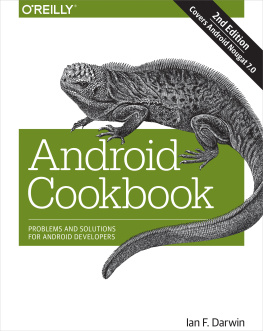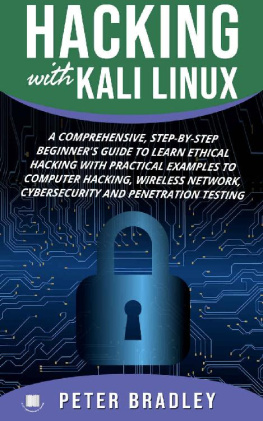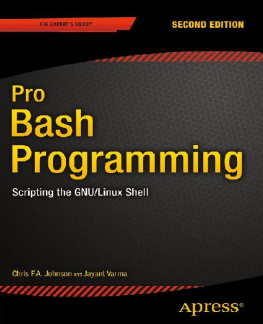Praise for TYE DARWIN
This is one of the most important hacking books that came after a long time. A must read for all beginners looking toward cybersecurity as a career pathway
Steve , Senior Penetration tester
Hacking Essentials Series has been one of the favorite sequential hacking books I have read in my lifetime
Anonymous Hacker Review
TYE DARWIN made me experiment with Kali Linux and helped me raise interest in Shell programming like no one ever did
Amazon Review
Linux for hackers
Learn Linux basics and bash,shell, Python scripting for hacking using Kali Linux
GVS PUBLICATIONS
Also by TYE DARWIN
Hacking for Beginners
Copyright 2020 by TYE DARWIN
All rights reserved.
No part of this book may be reproduced in any form or by any electronic or mechanical means, including information storage and retrieval systems, without written permission from the author, except for the use of brief quotations in a book review.
For all the hackers that changed the world by destroying and To all the programmers who built all over again with much more safety
To be a hacker you first need to be a programmer. To be a programmer you need not be a hacker, but developing hacking skill can boost your confidence exponentially
Anonymous Quote
Contents
Understanding Linux and Installing Your Favorite Linux Distro
Introduction
If you are a beginner you might be probably wondering what Linux is? Let me help you with the basic stuff. Linux is an operating system just like windows and MacOS but with more security and stability and customizability. And you know what? It is completely free and is open-source (that means source code is not hidden or encrypted).
Seems awesome right? But you might wonder why Linux is less popular among normal users. Linux is an operating system that is specifically developed by professionals for professionals. It offers very less creative software when compared to Windows and macOS. You can't find a photoshop version for Linux because Adobe thinks that Linux is not a platform that developers use to create their products.
Then, you may wonder who uses Linux as a daily work machine?
Linux may not be a creative operating system but is definitely a preferred choice by developers , programmers, ethical and unethical hackers, database system managers and system administrators. Linux is complex and definitely has a learning curve. Linux enthusiasts should be aware of commands and particularly an in-depth understanding of shell programming to achieve what they want using the Linux kernel.
Are you overwhelmed by the possibilities of Linux? Don't worry because we are here to help you introduce Linux with simple explanations and instructions. Welcome to the first module of this book where you will get a simple introduction to the Linux ecosystem and a detailed step-by-step installation instructions. Let us go!
Chapter One
Introduction to Linux
This chapter mainly describes some methods and experiences of learning Linux system, including how to choose a Linux distribution that suits you, as well as the relationship and applicable environment of each Linux distribution. Then it summarizes the general roadmap for learning Linux. It will also give sufficient information about building your own Linux learning environment, and finally will talk about some resources for learning Linux. By the study of this chapter, beginners will no longer feel confused in the process of learning Linux, and can find a learning method that suits them. Initially we will talk about some of the applications of Linux in everyday life.
Current status and trends of Linux in various fields
Many novices have a very confusing question:
"I have heard of Linux, but after learning the Linux system, what can you do on it? Or what can the Linux system specifically do?"
With this question, the book begins with an overview of Linux and its relationship with open source software. We will also talk about application fields and future development trends of Linux.
Linux and open source software
Linux is a free and open source UNIX-like operating system. The kernel of this operating system was first released by Linus Torvalds in 1991. After that, with the addition of user space applications, it became the Linux operating system.
Strictly speaking, Linux is just the operating system kernel itself. The term "Linux kernel" is usually used to express this. Linux is often used to refer to a complete operating system based on the Linux kernel, which includes GUI components and many other utilities.
The GNU General Public License (most commonly called as GNU GPL or GPL) is a widely used free software license agreement. Originally written by Richard Stallman for the GNU project, the GPL gives the definition of free software for computer programs. Any product derived from GPL software must be released under the GPL license and the source code must be disclosed.
Linux is the most famous example of the development of free software and open source software. As long as they follow the GNU GPL, any individual and organization can freely use all the underlying source code of Linux, and can also freely modify and redistribute it. With the rapid development of the Linux operating system, various integrated open source software and utility tools on Linux have also been applied and popularized. Therefore, Linux has also become synonymous with open source software. Red Hat Linux is one of the famous Linux operating systems that commercialized its tools to be sold for enterprises looking out a database administration system.
The development of Linux in the server field
With the increasing influence of open source software worldwide, the Linux server operating systems has occupied more and more market shares in the server operating system market structure and has conventionally formed a situation of large-scale market applications, and has maintained a rapid Growth rates, especially in key national areas such as government, finance, agriculture, transportation, and telecommunications. In addition, considering the rapid growth of Linux and the support of relevant national policies in different countries, Linux server products are bound to impact the larger server market.
According to statistics from authoritative departments, Linux currently has a 75% market share in the server field. At the same time, the rapid rise of Linux in the server market has attracted great attention from the global IT industry and has become the backbone of the server operating system field with a strong momentum.
Development of Linux in the desktop field
In recent years, especially in the technological market, the development trend of Linux desktop operating system is very rapid. The Linux desktop operating system launched by local system software vendors such as the winning Red Flag Linux, Deepin Linux, etc., has been widely used in the government, enterprises, OEM and other fields.
In addition, SUSE and Ubuntu have also launched Linux-based desktop systems, especially Ubuntu Linux, which has accumulated a large number of community users. However, from the perspective of the overall functions and performance of the system, there is still a certain gap between the Linux desktop system and the Windows series, mainly in terms of system ease of use, system management, software and hardware compatibility, and software richness. macOS is also popular among designers, creative professional in films and people who write books. Linux has a purpose and serve it well. So, does the other operating systems. As a hacker it is mandatory to understand the importance of Linux as it maybe hard to crack any system using windows and Mac software.









![Chris F.A. Johnson [Chris F.A. Johnson] - Pro Bash Programming: Scripting the GNU/Linux Shell](/uploads/posts/book/119669/thumbs/chris-f-a-johnson-chris-f-a-johnson-pro-bash.jpg)

